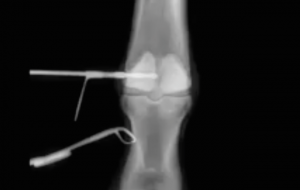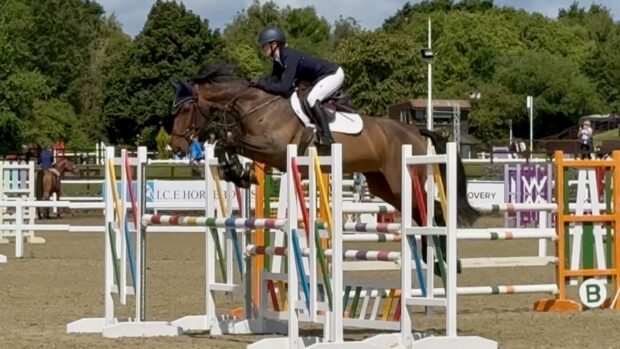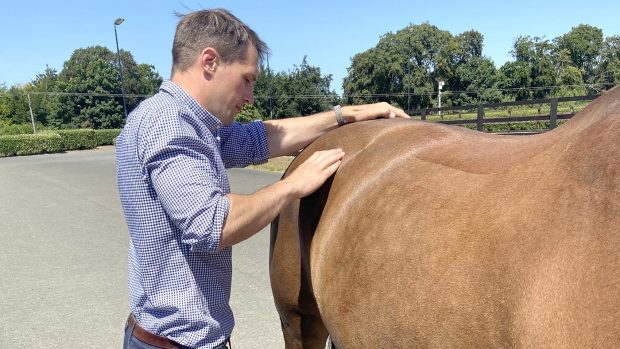A video released by The University of Edinburgh’s Royal (Dick) School of Veterinary Studies shows surgeon Eugenio Cillán-Garcia performing a “standing fracture repair” on a racehorse from start to finish, inserting two screws into the leg.
The six-year-old novice hurdler had suffered a “micro-fracture” to the cannon bone, which had not shown up on an X-ray, and the operation was aimed at preventing worsening of the injury. It was diagnosed through the use of scintigraphy and MRI.
His trainer Lucinda Russell, who saddled 2017 Grand National winner One For Arthur, told H&H: “He’d run below expectation in a race at the start of May and was unlevel after the race. He was sound in walk, but not in trot.
“It’s terrifying that nothing showed up on the X-ray, we were so proud in the old days that we could X-ray their legs, but actually now we’re not getting enough information from it.”
The surgery took place within 10 days of lameness being spotted.
NB: Please wait while the video loads below… if the video does not appear, click here to watch
Broken bone? No problem, we'll repair it standing
Its been a record year at the Dick Vet Equine Hospital for fractures, with a greater number and range than we've had before, perhaps its due to the hard ground after our wonderful summer? So far we've generally had great success, and we thought you might like to see whats involved, so here's a wee treat for you. In this video Dick Vet Equine Surgeon Dr Eugenio Cillan-Garcia fixes a fracture with the horse standing and sedated. We do this because it reduces the risks for the horse. We've speeded it up so you can see the whole process…enjoy
Posted by Dick Vet Equine on Thursday, August 23, 2018
Dr Cillán-Garcia told H&H the video shows combined diagnostic imaging using scintigraphy [bone-scanning], MRI and X-rays. “In this case the horse was developing the start of a fracture; a micro-fracture or weakening of the bone, which we were unable to see with the X-rays,” he said. “The beauty of this case was that we could see the site of the micro-fracture with scintigraphy, and then clearly see the configuration with MRI, which helped to guide our treatment.”
The procedure shown in the video involves two screws being inserted into the cannon bone.
“We put the screws in to get the leg strong enough in that place and to avoid the fracture progressing. Had that horse gone on racing, he would have suffered a really bad fracture and we could have lost the horse. Prevention is the key,” said Dr Cillán-Garcia.
The standing fracture repair is considered a modern practice compared to the past, when general anaesthesia would have been used.
“We had the horse sedated and a specialist anesthesia team helping with the sedation and keeping him quiet. Everything has to be very slick from the nurses to the anaesthetist,” said Dr Cillán-Garcia. “Everyone in the chain knows their place which allows the procedure to be done quite quickly. It’s a full team involved and I am proud of working in a place like the equine hospital at The Royal (Dick) School of Veterinary Studies. Without this fantastic team we would be unable to do this.”

The gelding was out of the hospital the next day and is on course to make a full recovery.
“This is a horse that doesn’t keep condition very well and one of the main advantages of the standing sedation procedure was that because he hadn’t had a general anaesthetic he recovered better and quicker overall,” said Lucinda.

Horses saved by pioneering surgery
A new kind of surgery can remove cataracts from horses’ eyes, enabling them to continue to compete rather than being

Headway in equine cataract surgery
A successful operation on a horse suffering from severe cataracts carried out at Liverpool University may herald a breakthrough in

Surgery for soft tissue swellings
Surgical removal of soft tissue swellings, where there is no associated lameness, is difficult and traumatic
Dr Cillán-Garcia said the gelding will come back to training with an excellent prognosis to race again.
“Put it this way, that area will be the strongest part of the horse’s body now,” said Dr Cillán-Garcia.
“I personally am very lucky, Eugenio is a fantastic addition to our team. We can look at the horses and try and prevent injury before it happens, in particular try and prevent catastrophic injuries,” said Lucinda. “In the time Eugenio has been working with us, our numbers of fatal fractures has dropped tremendously. This is one of the examples of it.”
For all the latest news analysis, competition reports, interviews, features and much more, don’t miss Horse & Hound magazine, on sale every Thursday.




